Social Networking and Online Videos Take Off
The internet is living up to its potential as a major source for news about the presidential campaign. Nearly a quarter of Americans (24%) say they regularly learn something about the campaign from the internet, almost double the percentage from a comparable point in the 2004 campaign (13%).
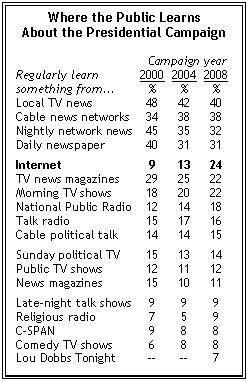
Moreover, the internet has now become a leading source of campaign news for young people and the role of social networking sites such as MySpace and Facebook is a notable part of the story. Fully 42% of those ages 18 to 29 say they regularly learn about the campaign from the internet, the highest percentage for any news source. In January 2004, just 20% of young people said they routinely got campaign news from the internet.
The quadrennial survey by the Pew Research Center for the People & the Press and the Pew Internet & American Life Project on campaign news and political communication, conducted Dec. 19-30 among 1,430 adults, shows that the proportion of Americans who rely on traditional news sources for information about the campaign has remained static or declined slightly since the last presidential campaign. Compared with the 2000 campaign, far fewer Americans now say they regularly learn about the campaign from local TV news (down eight points), nightly network news (down 13 points) and daily newspapers (down nine points). Cable news networks are up modestly since 2000, but have shown no growth since the 2004 campaign.
By contrast, the proportion of Americans who say they regularly learn about the campaign from the internet has more than doubled since 2000 – from 9% to 24%. National Public Radio is the only other news source to show significant growth since 2000; currently 18% say they regularly learn about the campaign from NPR, up from 12% eight years ago.
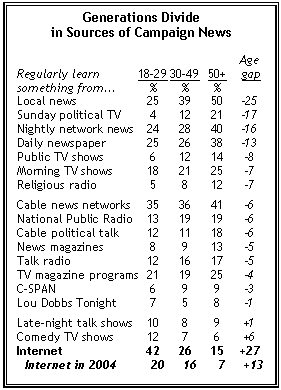
With more young people going online for campaign information, the age gap in campaign news sources has widened. As was the case in 2004, older Americans are more likely than younger people to learn about the campaign from many traditional news sources, particularly local TV news, Sunday TV political programs, nightly network news, and newspapers. The internet is the only major news source that young people use for campaign news at higher rates than older Americans – and this gap has more than doubled since 2004.
People who rely on the internet for campaign news turn to a wide array of websites. The most frequently mentioned online news outlets are MSNBC (at 26%), CNN (23%) and Yahoo News (22%). However, numerous other outlets also receive mentions, including non-traditional sources of campaign information; 3% each say they go to the Drudge Report or MySpace, while 2% specifically mention YouTube as a site where they get campaign news.
In this regard, substantial numbers of young people say they have gotten information on the campaign or the candidates from social networking sites such as MySpace and Facebook. Overall, more than a quarter of those younger than age 30 (27%) – including 37% of those ages 18-24 – have gotten campaign information from social networking sites. This practice is almost exclusively limited to young people; just 4% of Americans in their 30s, and 1% of those ages 40 and older, have gotten news about the campaign in this way.
At a time when a declining number of young people rely on television for most of their news about the campaign, a sizable minority are going online to watch videos of campaign debates, speeches and commercials. Roughly four-in-ten people under age 30 (41%) have watched at least one form of campaign video online, compared with 20% of those ages 30 and older.
However, even as the variety of campaign web information resources has expanded, there are indications that most internet users do not go online for the sole purpose of learning about the campaign. Rather, a majority of web users (52%) say they “come across” campaign news and information when they are going online to do something else. This practice is particularly prevalent among younger web users: 59% of web users under age 30 come across campaign news online compared with 43% of those ages 50 and older.
Pew’s 2004 political communications survey showed that many people, especially the young, learned about the presidential campaign from comedy programs such as The Daily Show and Saturday Night Live. These shows were not airing new episodes while the poll was conducted, as a result of the continuing strike by the Writers Guild of America. For the most part, people who get at least some news from comedy and late-night talk shows say they feel like they did not miss out on information about the campaigns when these shows were not on.
The survey, which was completed in late December, finds that Americans’ television viewing habits had not been greatly disturbed by the writers’ strike. About half (49%) say the strike has not affected the shows they watch, while 35% say that as a result of the strike some programs they watch have not aired new episodes. There was somewhat greater awareness of the toll the strike took on late-night and comedy programs. However, fewer than half of Americans (46%) knew that the strike affected shows like Letterman’s, Leno’s and Stewart’s, while 20% said – incorrectly – it has not, and 34% gave no response.
Main Source: TV on Top, But Slipping
Despite the growth of the internet for campaign news, television remains the public’s main source for such information. However, television is not as dominant as at once was: 60% say they get most of their news about the presidential election from television (local, cable and network outlets combined), down from 68% at comparable points in the 2004 and 2000 campaigns.
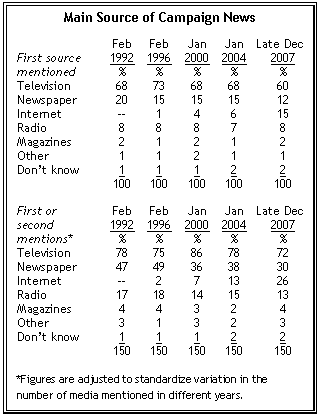
By this measure, the internet is still a secondary news source. Only 15% of Americans say they get most of their news about the election online, although that figure has more than doubled since 2004 (from 6%).
Overall, 26% of Americans mention the internet either first or second as their main source of election news. Among young people, the internet is eroding television’s advantage as a main source for election news. Six-in-ten of those ages 18 to 29 cite television as their main source for election news, down from 75% four years ago. Over that time, the proportion citing the internet has more than doubled – from 21% to 46%.
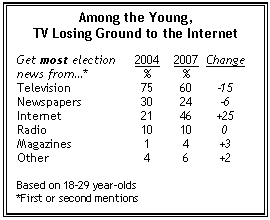
Notably, while newspapers were mentioned more often as a campaign news source among young people four years ago, today those under age 30 are almost twice as likely to mention the internet as newspapers as where they get most of their news about the election (46% vs. 24%).
Missing Stewart and Leno?
In January 2004, 8% of the public – but fully 21% of those under age 30 – said that they regularly learned something from comedy shows such as The Daily Show and Saturday Night Live. In the new survey, the same percentage of Americans (8%) say they regularly learned about the campaign from these comedy programs when they aired. However, a smaller proportion of those under 30 (12%) say they regularly learned about the campaign from comedy shows than did so in 2004. Because of the writers’ strike, respondents were asked to think back to when the shows were on, and to recall how much they learned about the campaign from these shows.
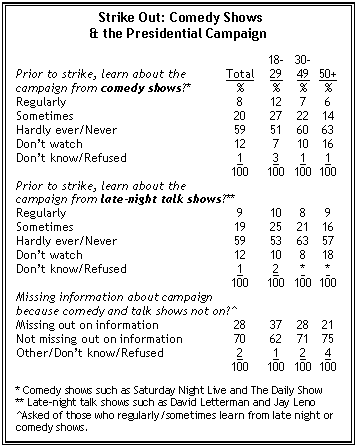
A Pew survey last winter found that the regular audiences of the comedy shows were as well informed as the audiences of elite news sources such as the websites of major daily newspapers and the News Hour with Jim Lehrer. (See What Americans Know: 1989-2007)
While many viewers of these shows undoubtedly learn while laughing, part of the reason for the high knowledge levels of those who faithfully watch these shows is that they tend to be heavy news consumers. Those who said they regularly learn from late night shows are far more likely than others to also report regularly learning from sources such as cable TV news shows, the internet, National Public Radio and talk radio, public television, and C-SPAN.
That may help account for the fact that only about a quarter (28%) of those who get at least some campaign news from comedy and late-night programs say they feel like they missed out on information about the campaign when those shows were not on. Among those under age 30, however, a larger minority (37%) says they feel like they missed out on campaign news in the absence of these programs.
Getting to Know the Candidates
As was the case in 2004, more Americans see the presidential candidates on news and entertainment programs than they do by watching the debates. Fully 57% say they have seen any of the candidates being interviewed on a news or entertainment program, up from 46% in 2004, when just the Democrats had a nomination contest.
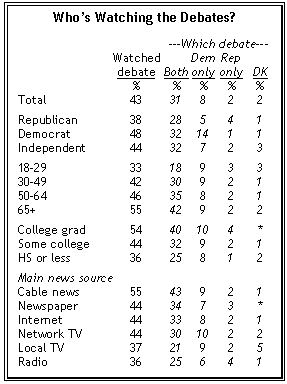
By comparison, 43% say they have watched one the presidential debates. Reflecting the Democrats’ greater engagement on the campaign, nearly half of Democrats (48%) say they have watched a debate in the past year, compared with 44% of independents and just 38% of Republicans.
In addition, far more Democrats than Republicans say they only watched a debate involving their own party’s candidates; 14% of Democrats say they have watched only a Democratic debate, compared with 4% of Republicans who only watched a GOP debate. About the same proportion of Democrats (32%) Republicans (28%) and independents (32%) say they watched the debates of both parties.
People who say they get most of their campaign news from cable news networks are more likely to have watched a debate than people who get their election news elsewhere. More than half (55%) of those who cite cable news as their main source of campaign information watched at least one presidential debate, the highest proportion of any campaign news audience.
The Big Three and the Long Tail
When asked where they get their campaign information online, three websites dominate the internet news landscape: MSNBC, CNN and Yahoo News. Each is cited by roughly a quarter of those who get campaign news online at least sometimes, and collectively, 54% cite at least one of these three websites.
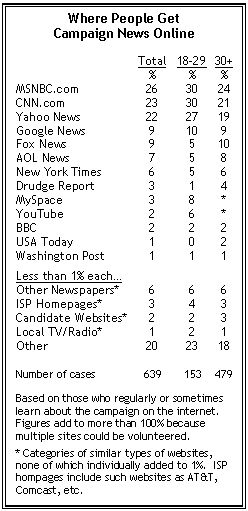
Other widely used websites include Google News (named by 9% of those who get campaign news online), Fox News (9%), AOL News (7%) and the New York Times website (6%). Other commercial websites mentioned by at least 1% are the Drudge Report (3%), BBC (2%) and the USA Today and Washington Post websites (1% each). MySpace is mentioned as a source of campaign information by 3% of those who get news online, and 2% name YouTube.
While the volume of users who get campaign news from MSNBC, CNN and Yahoo is noteworthy, there is also a remarkably “long tail” when it comes to online sources of campaign news. While only 13 individual websites were named by 1% or more of the people who get campaign news online, hundreds of individual websites were named by fewer than 1%.
All in all, more than a quarter (29%) of those who get news online name one of these smaller websites as a source of campaign information, meaning that for every person getting campaign news from a site like MSNBC or CNN, there is a person getting campaign news from a website that targets a far smaller audience (though they may often be the same individual.) Many of these “long tail” websites represent the web presences of local newspapers, TV stations and radio stations. But the vast majority are internet news websites – politically oriented or otherwise – that people count as sources of news and information.
Younger people who get campaign news online cite a wider variety of election news sources than do older people. When asked to offer websites they use, 41% of 18-29 year olds listed more than one website, compared with just 24% of people age 30 and over. Both MySpace and YouTube are sources of campaign information unique to younger people. MySpace is cited as a campaign news source by 8% of the younger online election news consumers – less than 1% of those ages 30 and over, and the pattern for YouTube is almost identical.
But younger online election news consumers also turn to the larger news sites in greater numbers as well. MSNBC, CNN and Yahoo News are cited as sources far more often by 18-29 year olds than by those who are older. In fact, 61% of younger people getting campaign news online list at least one of these three sites among their sources, compared with 46% of those age 30 and older.
Online Campaign Activities
While the internet is an increasingly important source of news about the presidential campaign, it also provides a way for people and campaigns to communicate about politics. About one-in-six Americans (16%) have sent or received emails with friends and family regarding candidates and the campaign, and 14% have received email messages from political groups or organizations about the campaign.
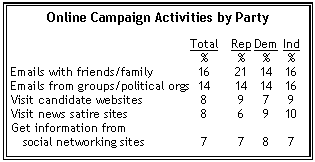
Fewer Americans have gone to the candidates’ websites themselves: just 8% say they have done so, the same number who report having visited news satire websites such as the Onion or the Daily Show.
Republicans are slightly more likely than Democrats or independents to report having traded email messages with friends and family, but otherwise there are no significant partisan differences in these activities. And except for visits to social networking sites, where young people are more frequent visitors, there are few systematic differences by age in each of these activities.
Social Networking Sites
While about one-in-five Americans overall (22%) uses an online social networking site such as MySpace or Facebook, these sites may be playing an important political role for some people, especially the young.
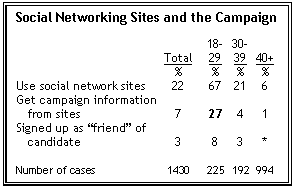
Fully two-thirds of Americans age 18-29 say they use social networking sites, and more than a quarter in this age group (27%) say that they have gotten information about candidates and the campaign from them – including 37% among those ages 18-24. Nearly one-in-ten of people under age 30 (8%) say that they have signed up as a “friend” of one of the candidates on a site. And the numbers are even higher for each of these activities among young registered voters.
The use of social networking sites for political activity is far less common among older voters, even those in their 30s. About one-in-five people ages 30-39 (21%) use social networking sites, but just 4% in this age group say that they have gotten campaign information from those sites; 3% have “friended” a candidate.
See It Now…On the Web
Online video has seen explosive growth on the web in the past few years, fueled by the rise of websites such as YouTube and the expansion of broadband ownership among the public. The potential political impact of web video was dramatically illustrated in the 2006 race for the U.S. Senate seat in Virginia, where a video showed incumbent Sen. George Allen mocking a young Indian-American campaign worker for his Democratic opponent. Allen’s loss in November was attributed at least in part to the widely circulated video.
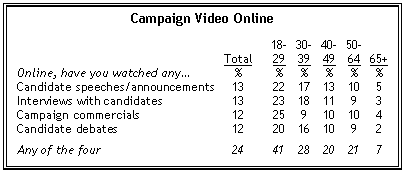
Nearly a quarter of Americans (24%) say they have seen something about the campaign in a video online – either a speech, interview, commercial, or debate. For each of these four types of videos, approximately 12-13% of those surveyed report seeing it online. Among younger respondents, the numbers are even higher. Fully 41% of those under age 30 have viewed at least one type of video. Fewer older respondents have seen some type of campaign video online, but even among those ages 65 and older, 7% have done so.
Perceptions of Bias
Most Americans (62%) believe there is a great deal (31%) or a fair amount (31%) of political bias in news coverage generally. This perception has changed little since early in 2004 when 65% said they saw at least a fair amount of political bias in news coverage.
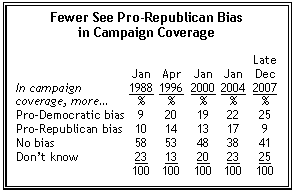
Regarding perceptions of bias in coverage of the presidential campaign, a quarter of Americans say news organizations are biased in favor Democrats, up slightly from 2004. But fewer people see a pro-Republican bias in campaign coverage than did so in 2004 (9% now vs. 17% then). A plurality of 41% sees no bias, compared with 38% in 2004.
Notably, Democrats – especially liberal Democrats – are less likely to view campaign coverage as biased toward the Republicans than they were four years ago. Currently, 23% of liberal Democrats say that coverage favors the Republicans, down from 36% in January 2004. Just 11% of conservative and moderate Democrats see a pro-GOP tilt, less than half the percentage in January 2004 (27%).
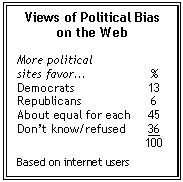
Regarding bias on the internet, 13% of web users say there are more news and opinion websites and blogs that favor the Democrats, while a smaller number (6%) say more sites tilt to the Republicans. But the predominant view (45%) is that there about equal numbers of news and opinion websites on both sides.
Combining the relatively large proportion of web users who did not offer an opinion (36%) with those who see approximately equal numbers of Democratic and Republican sites, about eight-in-ten web users (81%) see no decided political tilt to the news and political websites and blogs on the internet. The views of those who get most of their campaign news online are comparable with those of all web users.
Most Want News with No Point of View
Two-thirds of Americans (67%) say they prefer to get news with no particular point of view, while just 23% say they like getting news that reflects their political views. The balance of opinion regarding news has not changed since 2004.
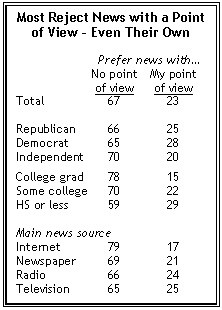
There are no significant partisan disagreements on this question, though there are modest educational differences. Roughly three-in-ten (29%) people with no greater than a high school education prefer news that reflects their political leanings compared with only about half as many college graduates.
Among those who get most of their news from television, there are no substantive differences of opinion among local, network, Fox News or CNN viewers. Large majorities in each news audience prefers news with no political point of view, while only about a quarter of each group likes news that reflects their own political preferences.
Iraq Views Turn More Negative
Public views of the situation in Iraq, which turned more positive in the fall, have again slipped. Currently, 41% of Americans say the military effort in Iraq is going very well or fairly well, while 54% say that the situation there is not going well.
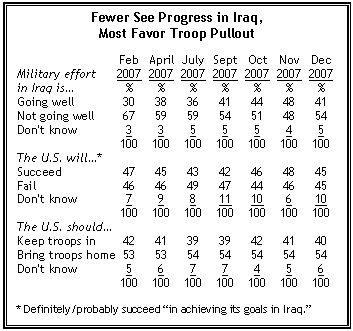
In November, opinion was split over progress in the military effort; 48% said things were going well there, the highest percentage expressing this view in more than a year (47% in September 2006). Both Republicans and Democrats are less likely to say the situation in Iraq is going well: currently, 66% of Republicans express a positive opinion of the situation, down from 74% in November. This shift among Democrats has been comparable (24% now, 33% then).
While positive perceptions of the military effort have declined in the past month, they still remain higher than they were earlier this year (30% in February). But support for withdrawing U.S. forces from Iraq as soon as possible remains strong, despite the improved views of the situation. Currently, 54% favor bringing U.S. troops home from Iraq, which is consistent with measures for the past year.
The public also remains divided over whether the United States will succeed or fail in achieving its objectives in Iraq. Fewer than half (45%) believe the U.S. will succeed while the same number (45%) says it will fail; the balance of opinion on this measure has changed very little since the beginning of last year.
More See Iraq as ‘Wrong Decision’
Negative views of the decision to go to take military action against Iraq are at their highest point since the war began almost five years ago. Slightly more than a third of Americans (36%) say the decision to use military force was right while 56% see it as wrong. In September 2007, 42% said the war was the right decision, compared with 50% who said it was wrong.
Views on the decision to go to war in Iraq remain deeply polarized along party lines. By 70%-26%, Republicans say the war was the right decision; by an even wider margin (76%-14%), Democrats believe the war was wrong. A solid majority of independents (61%) say the war was wrong compared with just a third (33%) who says it was right. The balance of opinion in all three groups is somewhat more negative regarding the decision to take military action than it was in September.




